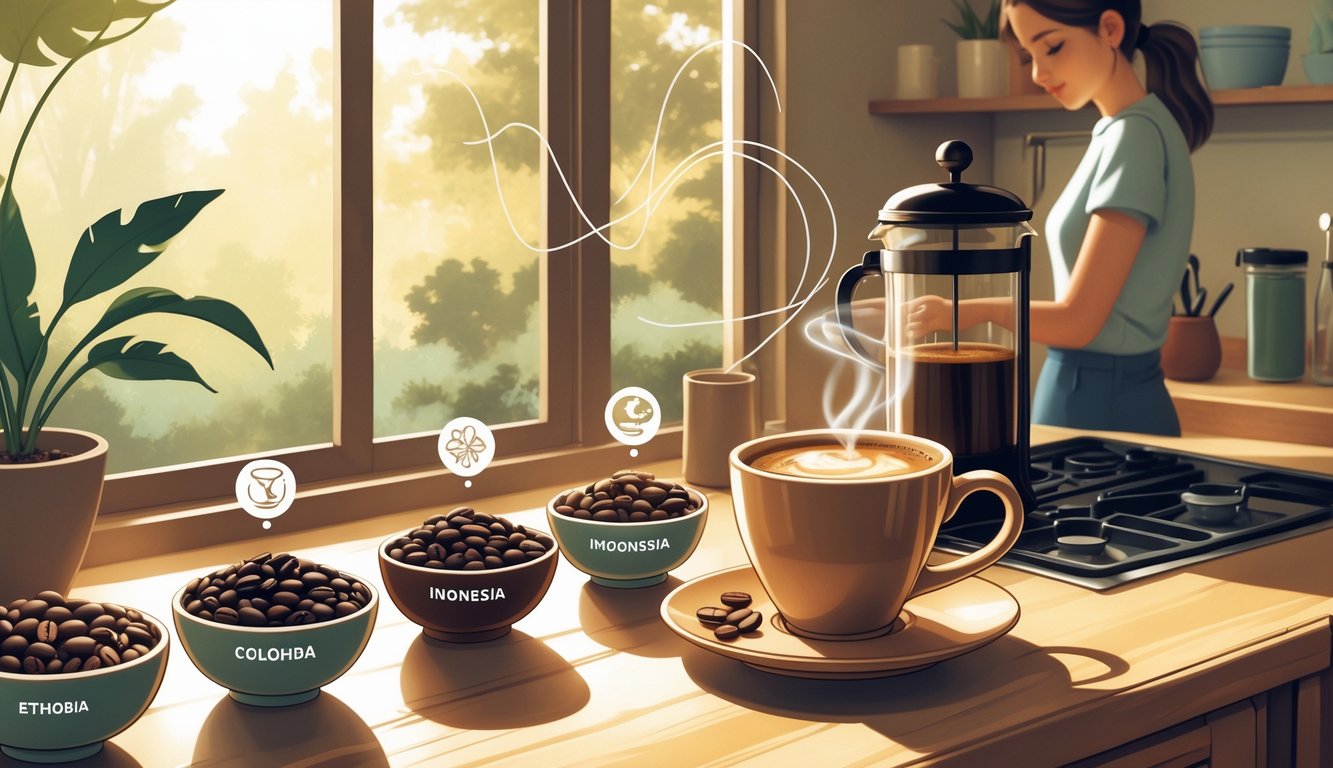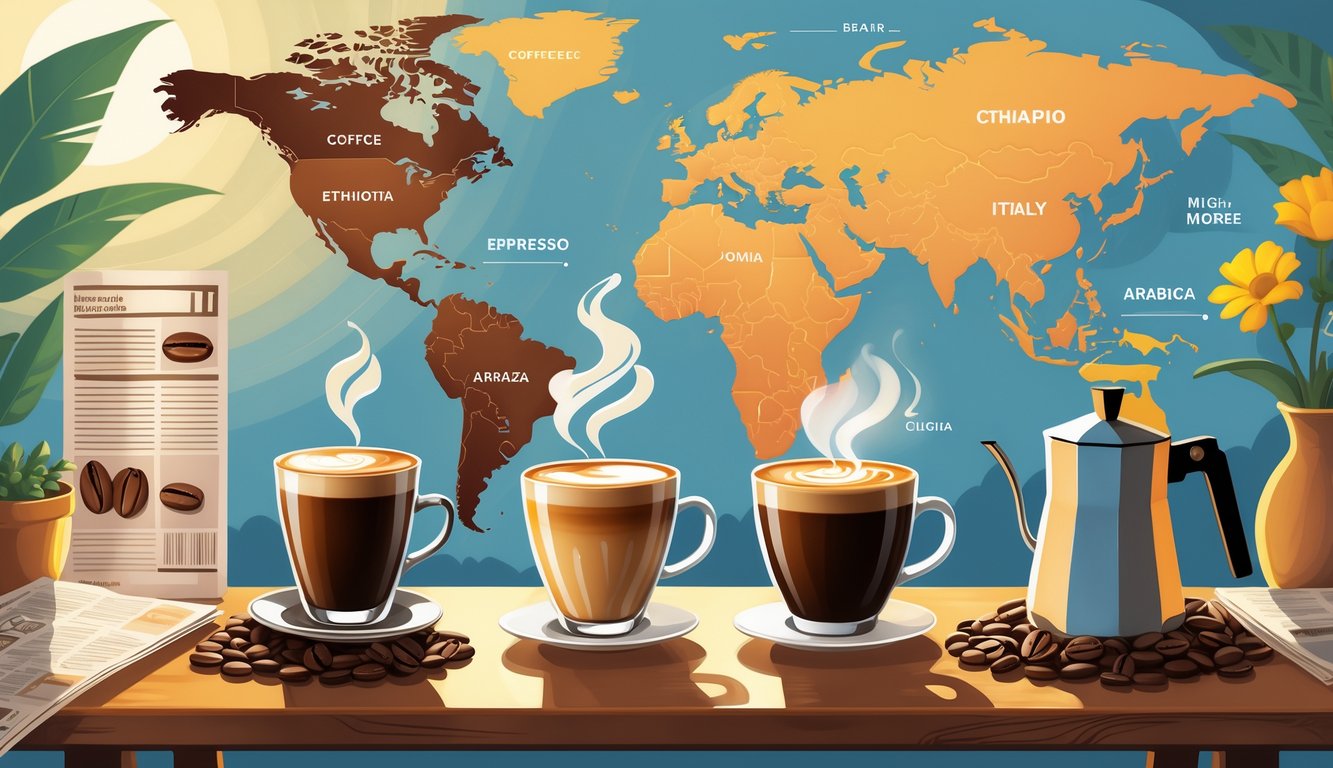
Espresso, Latte, and Moka Pot: Regional Twists

Switch up your beans and suddenly your “usual” is a disaster. Sometimes the differences between brewing and origin are just… too much. Maybe that’s what keeps it interesting?
Espresso and Latte with Diverse Beans
Why does espresso at an Italian café taste like actual magic, but mine at home is just “meh,” even when I splurge on fancy beans? I’m blaming the blend. Brazilian beans (pulped natural, whatever that means) turn lattes into peanut butter land. Ethiopian? It’s all acid and fruit and, honestly, sometimes way too bright for milk.
Baristas claim Latin American Arabicas are the “classic” for chocolatey espresso, but is that real or just coffee snobbery? Coffee Calculator Guide says altitude and climate mess with crema and aftertaste, so maybe it’s not just me. My machine couldn’t care less about my “Sicilian flat white” dreams.
If you want consistency, go start a spreadsheet. No one does, but, hey, you could.
Mastering the Moka Pot at Home
The Moka pot drives me nuts. With Sumatran or Java beans, it’s earthy, spicy, not subtle. I asked a local roaster (who only brews once a week, apparently) and he says robusta blends can handle the pressure, but delicate Ethiopians just get wrecked.
Honestly, the pot hides all those “flavor notes” the internet says I should taste. Is it me? Over-extracting? User error? Probably. I checked: drying, processing, grind size—every tiny thing wants to ruin your morning. East African beans go fruity and light unless you scorch them, which I do, a lot. Cup of Espresso has charts but, spoiler, trying every combo just made me more confused.
Exploring Aeropress and Drip Coffee Maker
Aeropress: people call it a “miracle,” but try it with oily, dark Asian beans and it’s a mud bath. Colombian single origin? Suddenly, it’s floral, sweet, almost weird. Drip machine is lazy but forgiving—Central American medium roast is less acidic, more chill. Supposedly, Coffee Voilà says environmental stuff like soil and weather totally change the cup.
I tried making a heatmap of results (don’t ask), and the only pattern is: there’s no pattern. Change the origin, get a different cup every time. Grind off by a hair? Guatemala goes from honey-smooth to sharp and tannic. Maybe that’s the fun part. Or maybe it’s just chaos. Anyone who says their drip has “baker’s chocolate notes” is probably using bottled water while I’m stuck with whatever comes out of my tap.
Modern Coffee Trends: From Cold Brew to Iced Coffee
Waking up, staring at the fridge, wondering if I’m doing cold brew or just microwaving yesterday’s leftovers—yeah, that’s my life. Trends crash into routines, and I’m not sure if it’s making things better or just more complicated. Some mornings I grind beans like I’m on a cooking show, other days it’s whatever’s closest.
The Rise of Cold Brew in Morning Routines
Every time I see another cold brew trend forecast, someone’s freaking out about stats. Cold brew is up 45% since last holiday season? 300% since, what, 2018? Wild. But if you’re not prepping jars overnight, does it even count as cold brew? I don’t know.
People swear it’s “less acidic, less bitter.” I guess I agree, if I remember to actually drink it before it gets lost behind the oat milk. Baristas love pushing it: “smooth,” “rich,” “five days in the fridge.” No hot water, less chaos, more caffeine. But then I forget which batch is which, and suddenly I’m stressed about old coffee. That’s progress, I guess.
Refreshing Iced Coffee Variations
Honestly, I used to think iced coffee was just sad, cold leftovers until someone shoved a glass of Japanese flash brew in my hand and, okay, fine, it’s not the same. Then suddenly there’s Vietnamese egg coffee, which sounds like a dare but actually works, and nitro cold brew in cans that show up in every gas station fridge. I mean, is there really a difference between a honey-cinnamon iced latte and one of those Starbucks blonde-espresso shaken things? Try them back to back—your brain gets whiplash. Sometimes I’m not even sure I like any of them, but I keep buying them, so what does that say about me?
Coffee shops now? It’s all cold foam, weird spicy syrups, oat milk, macadamia milk, whatever’s trending. Even the chains have these “custom ice ratios,” which is, what, a fancy way of saying you want more coffee and less water? Feels like there’s a new trick every week, and apparently cold drinks are outselling hot ones now, according to these flavor trend folks. Meanwhile, my aunt orders a “large regular iced” and acts like it’s a splurge. Who’s winning here? No clue.
Instant and Decaf Coffee Options
Here’s the thing about instant coffee: nobody’s drinking it for the taste. I’ve got a jar of those Colombian crystals in my desk drawer, and yeah, it’s not fancy, but at 7:48am when you’re late, you don’t care. Specialty baristas can roll their eyes all they want. Decaf is a whole other headache—people swap to Swiss Water Process beans so they’re not up all night, but let’s be real, it’s rarely as good. Food science friends swear decaf’s “cleaner” now, fewer chemicals, especially if you buy from third-wave shops, but is anyone actually excited for decaf? I’ve never seen it.
Sometimes I dump a scoop of instant into a smoothie just to shave off a minute. Viral coffee pods, TikTok hacks, dissolvable whatever—they’re all promising magic, but instant and decaf are pure survival, not some romantic ritual. Even the fanciest offices stash instant singles in the kitchen for emergencies. Either everyone’s pretending their mornings are calm, or we’re all just lying to ourselves.



